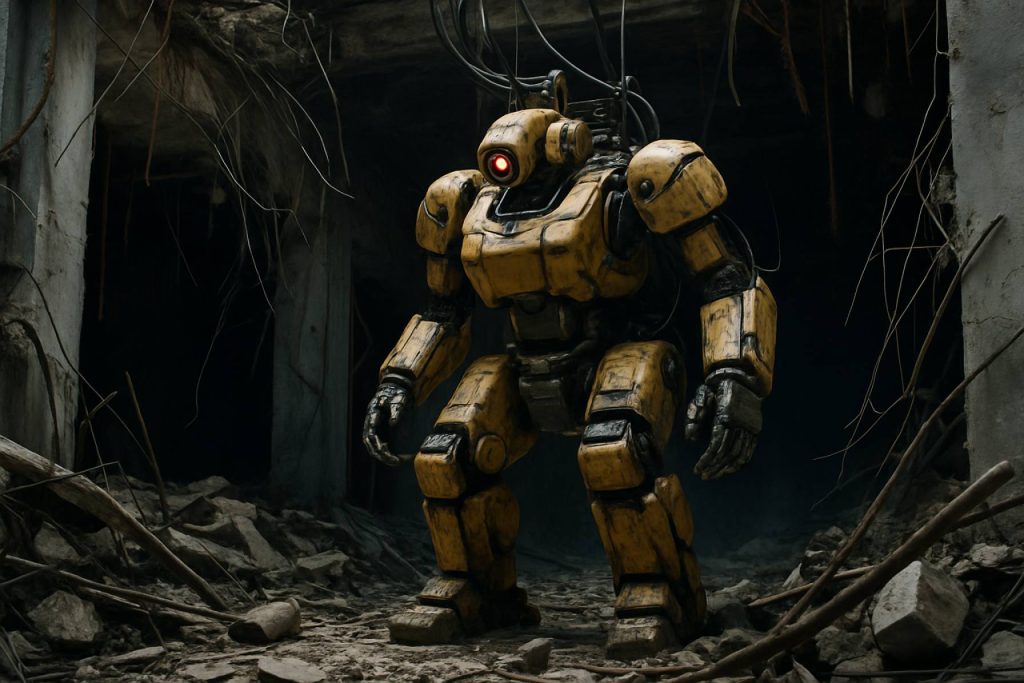
- The Fukushima Daiichi nuclear plant is relying on a 22-meter, 4.6-ton robotic arm to remove 880 tonnes of highly radioactive melted fuel debris from Reactor No. 2.
- Engineers spent six years and over $50 million developing the robot, designed to navigate extremely confined, hazardous spaces within the ruined reactor.
- Technical setbacks — including mechanical failures and cable breakdowns — have delayed the project and intensified scrutiny from regulators and critics.
- Alternative, smaller robots have been deployed after repeated issues, reflecting doubts about the large arm’s viability.
- Successful debris retrieval would mark a milestone for robotic solutions in nuclear decommissioning, but failure could prompt a major strategy overhaul for Fukushima’s cleanup challenge.
A chill grips the core of Japan’s most notorious nuclear plant, where hulking debris still holds secrets from the disaster that captured the world’s attention in 2011. Deep beneath Reactor No. 2 at the Fukushima Daiichi plant, engineers are betting on a machine unlike any before — an elongated, steel-jointed robotic arm primed to navigate catacombs untouched since the earthquake and tsunami shattered the reactor’s defenses.
Light gleams off the arm’s 22-meter length as technicians huddle, orchestrating its 18 agile joints, each a miniature marvel. At 4.6 tons, this is no mechanical toy. Its engineers have spent six painstaking years, and the backing of over $50 million in public investment, to bring it to life. Tasked with the near-impossible, the arm must slither through a battered access port scarcely wider than a dinner plate: a 55-centimeter opening, just 40 centimeters tall at its narrowest, before descending into a cramped, attic-like crawlspace beneath the radioactive heart of Reactor No. 2.
Their target? A stubborn, deadly legacy: 880 tonnes of melted nuclear fuel debris, a mixture threatening both the pace and possibility of Fukushima’s decommissioning. The retrieval of even a tiny sample would mark progress. Yet the path to victory is strewn with failure. Early trials showed the arm’s skeleton wavering under its own weight. On several occasions, vital cables frayed and failed. Its motors falter, the shielded tip sometimes striking the model containment vessel, each setback a stark reminder of the hostile environment awaiting.
The pressure rises as critics — some within Japan’s nuclear oversight — warn of the peril of sunk costs and unyielding plans. In the shadow of the abandoned No. 5 reactor, identical in structure to the robot’s true field, engineers painstakingly examine every movement. Will the variables align in the next scheduled test?
Mitsubishi Heavy Industries, collaborating with seasoned nuclear experts from the UK, pursues relentless improvements. The process embodies Japan’s philosophical struggle: relentless resolve meets hard reality in Fukushima’s ruined labyrinth. Meanwhile, alternatives — smaller, less capable machines — have stepped in to attempt sample retrievals, a tacit admission that the robotic arm, heavy with expectation, is facing the most decisive trial of its brief mechanical life.
As officials at TEPCO grapple with next steps, they acknowledge mounting unease over the project’s repeated delays. Some veteran regulators urge a cooler calculation: true progress, they argue, lies not just in perseverance, but in recognizing when to pivot, even if that means abandoning the gleaming symbol of technological hope.
With radiation’s invisible peril ever-present and the world watching, the Fukushima arm awaits its make-or-break moment. If successful, it could signal a leap in robotic intervention for nuclear crises worldwide — a testament to human ingenuity wrangling the consequences of disaster. If not, it risks fading into the plant’s crowded storerooms, a cautionary monument to the limits of engineering.
The fate of Fukushima’s cleanup now rests, quite literally, on the edge of a steel fingertip — a stark reminder that sometimes, even the mightiest machines must yield to the unforgiving realities etched by history.
For more on global energy challenges and initiatives, visit International Energy Agency.
Inside Fukushima: The Robot Arm Struggling to Solve Japan’s Biggest Nuclear Challenge
—
Unveiling the Full Story Behind Fukushima’s High-Stakes Robotic Rescue
The 2011 Fukushima Daiichi nuclear disaster remains one of the world’s most notorious environmental and technological crises. Over a decade later, the decommissioning effort is both a testament to modern engineering and a sobering lesson in the limitations of even the most advanced technology. Beneath the focus on the recently engineered robotic arm at Reactor No. 2, there are facts, challenges, innovations, and controversies that haven’t fully come into view—until now.
—
Unexplored Facts and Essential Context
1. The Scale of the Problem
– In total, around 880 tonnes of melted nuclear fuel debris (“corium”) are trapped inside Reactors 1, 2, and 3 at Fukushima—far more challenging to retrieve than originally estimated by Tepco and Japanese authorities.
– The fuel remains mixed with mangled steel, concrete, and reactor materials, forming a highly radioactive mass that conventional retrieval technology cannot handle (Source: TEPCO).
2. How It Compares Globally
– Other nuclear disasters (Three Mile Island, Chernobyl) faced radically different cleanups: Chernobyl entombed its reactor in concrete (sarcophagus), while Three Mile Island involved submerged debris, eventually extracted robotically over a decade.
– Fukushima’s coastal, groundwater-riddled site, and earthquake-damaged structure make access and decommissioning uniquely perilous.
3. Robotic Limitations and Engineering Hurdles
– Fukushima’s radiation destroys electronics within hours to days, rendering standard robotics nearly useless unless fully shielded—greatly increasing size, weight, and cost.
– The new robotic arm’s 18 joints use radiation-hardened servo motors and sensors, but heavy shielding sometimes interferes with maneuverability—an unsolved dilemma in disaster robotics research.
4. Alternative and Backup Approaches
– Throughout 2022-2023, smaller, spider-like robots were used to scout, photograph, and attempt to retrieve micro-samples. They discovered fuel debris clings to internal surfaces, and even approaching it kicks up radioactive dust.
– There are ongoing proposals to build “contain-and-isolate” solutions (e.g., permanent underwater storage or sarcophagus approaches) should direct removal prove impossible.
5. Economic and Social Impact
– Japan’s government estimates the full cleanup could cost $200–$300 billion and span 30–40 years (World Nuclear Association).
– Communities near Fukushima still await full decontamination, limiting resettlement and economic recovery.
– Public trust in nuclear energy in Japan remains extremely low: in recent polls, over 60% oppose nuclear plant restarts.
6. Controversies and Criticisms
– Environmental groups like Greenpeace have criticized Japan’s plan to dump treated radioactive water from Fukushima into the Pacific Ocean (Reuters, 2023). TEPCO insists this meets safety standards.
– Some engineers warn of “sunk cost fallacy”—that pursuing the robotic arm may divert funds and time from simpler, possibly more effective remediation strategies.
7. Market Trends and Technological Insights
– Japan’s robotics and AI industries have spun off Fukushima-inspired innovations in fields like hazardous industrial cleanup, mining, and deep-sea research.
– Increasing demand is projected for disaster robotics in the Asia-Pacific region, with the global market for hazardous environment robotics expected to surpass $18 billion by 2028 (MarketsandMarkets).
—
Pressing Reader Questions Answered
Q: Can the robot really retrieve the fuel debris?
– It’s unproven, and even retrieving a few grams will be considered a major milestone. Each movement is carefully rehearsed, but unforeseen obstacles in a chaotic, radioactive environment could still result in failure or setbacks.
Q: What’s the radiation risk for the robots and humans?
– Robots, not humans, are deployed in the highest-radiation zones, but even the most shielded machines can malfunction after prolonged exposure. Surface (non-reactor) workers wear protective gear and undergo daily monitoring; radiation doses at the site remain well above typical background levels but have fallen since 2011.
Q: What happens if the robot fails?
– Plans include fallback to smaller devices or switching to remote retrieval by hydraulic tools, as well as possible partial containment rather than full removal. International experts are on standby to advise on alternative containment or isolation methods.
—
How-To Steps: Safe Nuclear Debris Retrieval
1. Pre-Survey: Deploy remote cameras, scouts, and dosimeters to map obstacles and radiation hotspots.
2. Robotic Preparation: Test robot on full-scale mock-ups under simulated radiation conditions.
3. Soft Entry: Use arm’s smallest-diameter tools to probe and sample fuel debris.
4. Secure Retrieval: Extract minimal debris for analysis, confirming composition and radiation level.
5. Decontaminate & Dispose: Safely package and store retrieved material under government guidelines.
—
Pros & Cons Overview
Pros:
– First-of-its-kind robotic solution; potential globally for disaster response
– Limits human exposure to lethal radiation
– Advances high-precision robotics and AI for industrial and emergency use
Cons:
– Unproven at scale; prone to mechanical and electronic failure under high-radiation
– High operational and financial cost
– Protracted timeframe, with no guarantee of total success
—
Real-World Use Cases
– Technologies from Fukushima are now used in deep-sea oilwell repair and space exploration (JAXA robotic arm technology stems partly from disaster robotics).
– Hazardous chemical plants and abandoned mines use similar robotic surveyors to mitigate human risk.
—
Predictions & What’s Next
Experts predict increased global reliance on robotic technologies for radioactive cleanup as aging nuclear plants and disaster sites proliferate. Japan’s success or failure at Fukushima will influence regulatory, engineering, and public opinion on nuclear power for decades.
—
Quick Tips for Readers
– Follow expert updates from International Atomic Energy Agency for unbiased technical assessments and global nuclear decommissioning best practices.
– Understand risk: nuclear decommissioning is a marathon, not a sprint; engineering solutions evolve with experience.
– Innovations in disaster robotics will likely benefit future accident responses, both nuclear and beyond—watch for related breakthroughs in medical, construction, and environmental cleanup fields.
—
In summary, while Fukushima’s robotic arm faces daunting odds, it’s more than a technical fix: it’s a living laboratory for the future of hazardous environment intervention. Regardless of its immediate outcome, each attempt pushes the boundaries of what tech—and human resolve—can achieve. For evolving industry trends, global energy insights, and technology forecasts, visit the International Energy Agency.



